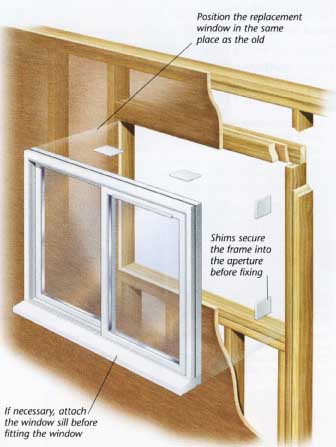This is a much easier job when tackled by two people. You should preorder the replacement window and check its size on arrival. Having removed the old window and prepared the opening using the techniques described opposite, you will usually be able to fix a window directly through the frame into the wall. Always install the new frame at the same depth in the wall as the one you have removed. Seal the frame after installation.
FURTHER INFORMATION
- A hard hat is advisable, and necessary for work above head height. Goggles, gloves, and work boots are essential.
- To fit a window, you need interior and exterior access. To work on upper-level windows, fixed scaffolding or pipe staging is essential. You may also require a raised platform to replace ground-level windows, especially taller designs.
- Use drop cloths inside the house to protect surfaces from debris and dust.
INSTALLING A WINDOW
How you install a window depends on your wall type and window design. Always follow any specific instructions that come with the window you purchased. However, the general technique is always similar. If you need to put in a new window sill, attach this into the bottom of the frame before you install the window.
Positioning the new window
Place the window in the rough opening in the same position that the old window occupied. Drive wood shims beneath the sill or frame to get it level and tight against the header. Use a level to ensure that the frame is horizontally and vertically straight. Gently insert shims down either side of the frame to hold it in position, not so tightly that they distort the shape of the frame. Measure the distance diagonally between opposite corners, and make sure both measurements are the same. Adjust the shims if necessary.
Fixing the frame
Open the casements to provide access to the side of the frame. Drill pilot holes for 4-in (100-mm) frame fasteners through the frame and into the wall below. Every 1 ft (300 mm) should be sufficient. Hammer the nails in until the plugs sit flush with the frame. Use a cordless drill-driver to screw them so that they countersink into the frame and hold it securely in position. Avoid over-tightening, as this can distort the frame. If possible, fix through the top of the frame, but in many cases this will be impossible because of the header. Fix the bottom edge of the frame if the sill and frame depth allow. Bottom fixings aren't recommended by some window manufacturers.
Finishing the job
Saw off or chisel away any protruding shims. Fill any large gaps around the frame with expanding foam. You will need to protect vinyl window frames with low-tack masking tape (blue painter’s tape) if they have no protective film because the foam may damage the finish. Once the foam is dry, trim it neatly using a utility knife. Apply a thin, neat line of cement (a fillet) around the joint with the wall to hide the foam. On wood-framed homes, use wooden moldings, or for vinyl windows use the cover strips supplied. Create a final seal with a continuous bead of caulk around the edge of the window frame. Glaze windows where necessary.
Installing a window frame: Inserting a frame into
all types of walls is similar -- position the new frame in the same
place as the one you removed and fix it in position. Use suitable fixings
for the window, and the point to which you are fixing it. Position
the replacement window in the same place as the old; if necessary,
attach the window sill before fitting the window.